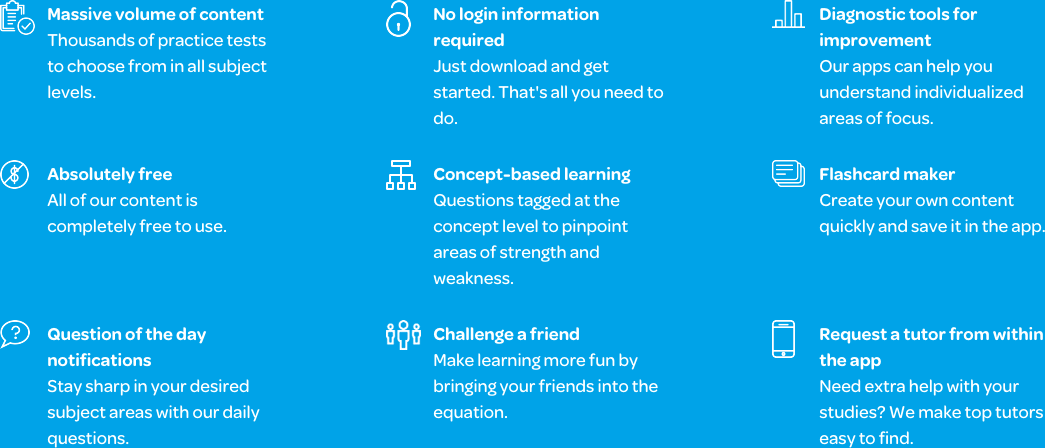The Varsity Tutors SAT II World History Mobile App
Taking the SAT Subject Test in World History is a great way to show your passion for and knowledge of world history to the college or university you plan to attend. The free Varsity Tutors SAT World History app for iPhone, iPad, and Android devices can help you as you work toward a great score on that test. It gives you on-the-go convenience, so you can study anytime, anywhere.
Formerly known as the SAT II World History Test, the test uses the time designations BCE and CE. It consists of 95 multiple-choice questions, and you have 60 minutes to complete them. You must be familiar with vocabulary and the cause and effect relationships of historical incidents and periods. You will also need to have a mastery of geography in order to do well. In addition, you will be expected to use the historical knowledge you already have to extrapolate information from graphs, charts, maps, or passages.
The test covers four broad time periods. The topics of Prehistory through 500 CE include ancient Greece and the rise and fall of the Roman Empire; global developments in agriculture, religion, trade, and writing; the Ice Age; and events in non-European regions such as East Asia, China, North and South America, Ancient Egypt, and the Persian Empire.
The topics covered between 500-1500 CE include feudalism, historical figures of the Middle Ages, the impact of Christianity, and political reforms of the Middle Ages. You will explore the impact of Islam, the Crusades, and a variety of other world religions.
In the era between 1500 and 1900 CE, you will need to know about the Age of Exploration and rise of Protestantism, the Enlightenment Era, and the Renaissance. Finally, topics of the period spanning 1900 CE to the present day include major events and movements from societies around the world, World Wars I and II, the nuclear threat, and the Cold War.
There are a variety of helpful SAT World History tools available on the app. You might want to begin by taking a full-length, timed practice test to see how you would do if you were to take the test today. This will illustrate, in great detail, your strengths and weaknesses on the subject. You can take these tests as many times as you like, all the while keeping track of your scores and watching your progress.
Once you know what concepts you need to study, you can use Learn by Concept and the built-in flashcards to spend time reviewing just the areas in which you need more review. The questions are professionally written to be as challenging as the questions you’ll face on test day. You can even use the Flashcard Maker to create your own flashcards with custom audio, images, and text.
Make your review more convenient by downloading the free Varsity Tutors SAT World History Subject Test app from iTunes or the Google Play Store, and get started mastering the material today!
66 mobile apps to choose from for your tutoring needs.

Learn More
As a high school student interested in pursuing a college degree, you might want to consider an SAT Subject Test. These standardized tests are administered by The College Board, and are a great way to boost the visibility of your college application. By taking an SAT Subject Test, you may not only increase the chances of being accepted into a high ranking university, but you give the staff the chance to evaluate your proficiency level and make an informed judgement about your placement.
If you are someone who is planning on studying history, you should consider taking the SAT Subject Test in World History. Until 2005, this test was known as the SAT II World History Test. As you might expect, the test is a comprehensive assessment of your knowledge of world history, so it provides prospective schools a chance to understand your command of these important historical topics.
You will have exactly one hour to answer 95 multiple-choice questions. Each question comes with five possible answers, but only one of the answers is correct. Each correct answer will give you one point, whereas a blank or incorrect answer will deduct one-fourth of a point from your final mark. The test is broken down into five sections: prehistory, 500 – 1500 C.E., 1500 – 1900 C.E., everything after 1900 C.E., and cross-chronological events. History from all continents, with the exception of Antarctica, is covered in this exam.
The test fodder begins with the Paleolithic Era, when nomadic humans roamed Africa, Asia, and Europe. By 15,000 B.C.E., some hunters migrated across the Bering Strait and became the first inhabitants of the Americas.
A lot happened in this time period that you may find on the test. Around 8000 B.C.E, communities along the Mediterranean began forming farming villages and experimenting with agriculture. By 2750 B.C.E., the story of Gilgamesh was told. This story, as well as Noah and the Ark, both document a great flood that happened around the same time period. It is now believed that a massive flood did occur, placing many people between the Mediterranean and the Black Sea in danger, which might have led to a mass exodus known as the “Great Indo-European Diaspora.”
Many important historical events you may find on the SAT World History Test happened within the Fertile Crescent. Cities began to emerge, various cultures discovered writing, and money and complex economies were invented. Hammurabi’s Code was invented, laying the groundwork for law. Additionally, you should note the various cultures of the region: the Assyrians, Hebrews, Egyptians, and Babylonians.
As you move towards the Bronze Age, you will need to know about Ancient Greek civilization. You should note how government worked, and you should understand the concept of Greek City-States. You should also know the various Greek philosopher and religions, and be familiar with influential Athenians and Spartans.
While Greece was known for being a highly educated society, Romans were regarded as a conquering nation. You are expected to know the similarities between Greek and Roman religions, the rise of the Roman Empire, and the introduction of Roman law. You should be versed in the various wars, as well as the massive expansion that the empire underwent.
By the time that Rome became a Christian empire, it was already on the decline. The SAT World History Test may include questions about the indigenous European tribes that Romans engaged in conflict with, as well as Constantine’s conversion to Christianity. Be sure you know about the Fall of Rome, and the power vacuum that sent the Western world into the Dark Ages.
While the Dark Ages were characterized by a number of tribes fighting across Europe, it was also a golden age for Islamic scholars. You are expected to know about Mohammed, the rise of Islam, and the famous Islamic scholars. The Moorish conquest of the Iberian Peninsula may also be included.
Two influential themes were prominent during the Medieval Period: chivalry and feudalism. During this time, you should know about the technological marvel known as plate armor, the establishment of feudal manors, and the relationship between lords and serfs. This was also the period of the Great Schism that separated the church into two: the Roman Catholic Church and the Eastern Orthodox Church. Be sure to note the importance of religion during this time period, and how it was the motivating factor behind the Great Crusades.
By the time that you get to the Renaissance, you will notice that European cultures have taken a keen interest in the academics of Ancient Greece. This time period is home to artistic and engineering marvels, and is also the first time a large bank was established: the Medici Bank. You should also be familiar with Martin Luther and the Protestant Reformation, and the subsequent wars that happened as a result.
The Age of Exploration is likely to be covered on the test, as well as how Spain and France colonized the New World, which they would hold the largest influence over for the next century, until the British established themselves as a world superpower.
Another important time period to explore is the period of industrialization, and how the Industrial Revolution changed the face of the Western world. Not only did this movement change the way that business was conducted, but it changed the way workers functioned in society. Along with productivity, it also brought significant new problems, which led to the creation of sociology. Two prominent critics of the Industrial Revolution were Friedrich Engels and Karl Marx, who developed communism.
Other important topics are French and British colonialism, and the rise of nationalism and how it led to World War I. Additionally, you should link the effects of the Treaty of Versailles to the rise of fascism, and the subsequent skirmishes that led to World War II.
Following World War II, the test will include questions about how the Western world jumped into the Cold War. During this time, Great Britain and the United States worked together to fight the spread of communism. This resulted in the Korean War and the Vietnam War.
Because the content covered on the SAT Subject Test in World History is extensive, you are recommended to study a year-long course in world history. Not only will you be required to know important dates and events, but you should also be able to think critically about key events, establish cause and effect relationships, and have a greater understanding of the geography of different time periods.




